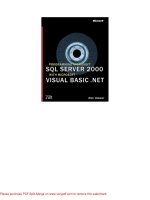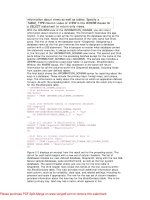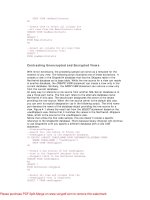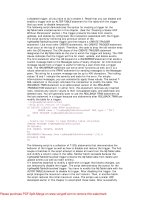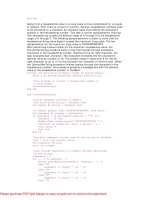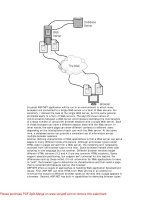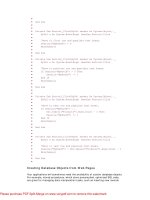parallel programming with microsoft visual c doc
Bạn đang xem bản rút gọn của tài liệu. Xem và tải ngay bản đầy đủ của tài liệu tại đây (8.87 MB, 186 trang )
www.it-ebooks.info
ISBN 978-0-7356-5175-3
This document is provided “as-is.” Information and views expressed in this
document, including URL and other Internet website references, may change
without notice. You bear the risk of using it. Unless otherwise noted, the
companies, organizations, products, domain names, email addresses, logos,
people, places, and events depicted in examples herein are fictitious. No
association with any real company, organization, product, domain name, email
address, logo, person, place, or event is intended or should be inferred. Comply-
ing with all applicable copyright laws is the responsibility of the user. Without
limiting the rights under copyright, no part of this document may be reproduced,
stored in or introduced into a retrieval system, or transmitted in any form or by
any means (electronic, mechanical, photocopying, recording, or otherwise), or for
any purpose, without the express written permission of Microsoft Corporation.
Microsoft may have patents, patent applications, trademarks, copyrights, or
other intellectual property rights covering subject matter in this document.
Except as expressly provided in any written license agreement from Microsoft,
the furnishing of this document does not give you any license to these patents,
trademarks, copyrights, or other intellectual property.
© 2011 Microsoft Corporation. All rights reserved.
Microsoft, MSDN, Visual Basic, Visual C++, Visual C#, Visual Studio, Windows,
Windows Live, Windows Server, and Windows Vista are trademarks of the
Microsoft group of companies.
All other trademarks are property of their respective owners.
www.it-ebooks.info
Contents
xi
Tony Hey
xiii
Herb Sutter
xv
Who This Book Is For xv
Why This Book Is Pertinent Now xvi
What You Need to Use the Code xvi
How to Use This Book xvii
Introduction xviii
Parallelism with Control Dependencies Only xviii
Parallelism with Control and Data
Dependencies xviii
Dynamic Task Parallelism and Pipelines xviii
Supporting Material xix
What Is Not Covered xx
Goals xx
xxi
1 Introduction
The Importance of Potential Parallelism
Decomposition, Coordination, and Scalable Sharing
Understanding Tasks
Coordinating Tasks
Scalable Sharing of Data
Design Approaches
Selecting the Right Pattern
A Word about Terminology
The Limits of Parallelism
A Few Tips
Exercises
For More Information
www.it-ebooks.info
vi
2 Parallel Loops
The Basics
Parallel for Loops
parallel_for_each
What to Expect
An Example
Sequential Credit Review Example
Credit Review Example Using
parallel_for_each
Performance Comparison
Variations
Breaking out of Loops Early
Exception Handling
Special Handling of Small Loop Bodies
Controlling the Degree of Parallelism
Anti-Patterns
Hidden Loop Body Dependencies
Small Loop Bodies with Few Iterations
Duplicates in the Input Enumeration
Scheduling Interactions with
Cooperative Blocking
Related Patterns
Exercises
Further Reading
Parallel Tasks
The Basics
An Example
Variations
Coordinating Tasks with Cooperative Blocking
Canceling a Task Group
Handling Exceptions
Speculative Execution
Anti-Patterns
Variables Captured by Closures
Unintended Propagation of Cancellation Requests
The Cost of Synchronization
Design Notes
Task Group Calling Conventions
Tasks and Threads
How Tasks Are Scheduled
Structured Task Groups and Task Handles
Lightweight Tasks
Exercises
Further Reading
www.it-ebooks.info
vii
4 Parallel Aggregation
The Basics
An Example
Variations
Considerations for Small Loop Bodies
Other Uses for Combinable Objects
Design Notes
Related Patterns
Exercises
Further Reading
Futures
The Basics
Futures
Example: The Adatum Financial Dashboard
The Business Objects
The Analysis Engine
Variations
Canceling Futures
Removing Bottlenecks
Modifying the Graph at Run Time
Design Notes
Decomposition into Futures
Functional Style
Related Patterns
Pipeline Pattern
Master/Worker Pattern
Dynamic Task Parallelism Pattern
Discrete Event Pattern
Exercises
6 Dynamic Task Parallelism
The Basics
An Example
Variations
Parallel While-Not-Empty
Adding Tasks to a Pending Wait Context
Exercises
Further Reading
7 Pipelines
Types of Messaging Blocks
The Basics
www.it-ebooks.info
viii
An Example
Sequential Image Processing
The Image Pipeline
Performance Characteristics
Variations
Asynchronous Pipelines
Canceling a Pipeline
Handling Pipeline Exceptions
Load Balancing Using Multiple Producers
Pipelines and Streams
Anti-Patterns
Copying Large Amounts of Data between
Pipeline Stages
Pipeline Stages that Are Too Small
Forgetting to Use Message Passing for Isolation
Infinite Waits
Unbounded Queue Growth
More Information
Design Notes
Related Patterns
Exercises
Further Reading
Resource Manager
Why It’s Needed
How Resource Management Works
Dynamic Resource Management
Oversubscribing Cores
Querying the Environment
Kinds of Tasks
Lightweight Tasks
Tasks Created Using PPL
Task Schedulers
Managing Task Schedulers
Creating and Attaching a Task Scheduler
Detaching a Task Scheduler
Destroying a Task Scheduler
Scenarios for Using Multiple Task Schedulers
Implementing a Custom Scheduling Component
www.it-ebooks.info
ix
The Scheduling Algorithm
Schedule Groups
Adding Tasks
Running Tasks
Enhanced Locality Mode
Forward Progress Mode
Task Execution Order
Tasks That Are Run Inline
Using Contexts to Communicate with the Scheduler
Debugging Information
Querying for Cancellation
Interface to Cooperative Blocking
Waiting
The Caching Suballocator
Long-Running I/O Tasks
Setting Scheduler Policy
Anti-Patterns
Multiple Resource Managers
Resource Management Overhead
Unintentional Oversubscription from Inlined Tasks
Deadlock from Thread Starvation
Ignored Process Affinity Mask
References
The Parallel Tasks and Parallel Stacks Windows
Breakpoints and Memory Allocation
The Concurrency Visualizer
Scenario Markers
Visual Patterns
Oversubscription
Lock Contention and Serialization
Load Imbalance
Further Reading
Further Reading
www.it-ebooks.info
xi
Foreword
At its inception some 40 or so years ago, parallel computing was the
province of experts who applied it to exotic fields, such as high en-
ergy physics, and to engineering applications, such as computational
fluid dynamics. We’ve come a long way since those early days.
This change is being driven by hardware trends. The days of per-
petually increasing processor clock speeds are now at an end. Instead,
the increased chip densities that Moore’s Law predicts are being used
to create multicore processors, or single chips with multiple processor
cores. Quad-core processors are now common, and this trend will
continue, with 10’s of cores available on the hardware in the not-too-
distant future.
In the last five years, Microsoft has taken advantage of this tech-
nological shift to create a variety of parallel implementations. These
include the Microsoft
®
Windows
®
High Performance Cluster (HPC)
technology for message-passing interface (MPI) programs, Dryad,
which offers a Map-Reduce style of parallel data processing, the Win-
dows Azure™ technology platform, which can supply compute cores
on demand, the Parallel Patterns Library (PPL) and Asynchronous
Agents Library for native code, and the parallel extensions of the
Microsoft .NET Framework 4.
Multicore computation affects the whole spectrum of applica-
tions, from complex scientific and design problems to consumer ap-
plications and new human/computer interfaces. We used to joke that
“parallel computing is the future, and always will be,” but the pessi-
mists have been proven wrong. Parallel computing has at last moved
from being a niche technology to being center stage for both applica-
tion developers and the IT industry.
But, there is a catch. To obtain any speed-up of an application,
programmers now have to divide the computational work to make
efficient use of the power of multicore processors, a skill that still
belongs to experts. Parallel programming presents a massive challenge
for the majority of developers, many of whom are encountering it for
www.it-ebooks.info
xii
the first time. There is an urgent need to educate them in practical
ways so that they can incorporate parallelism into their applications.
Two possible approaches are popular with some of my computer
science colleagues: either design a new parallel programming language,
or develop a “heroic” parallelizing compiler. While both are certainly
interesting academically, neither has had much success in popularizing
and simplifying the task of parallel programming for non-experts. In
contrast, a more pragmatic approach is to provide programmers with
a library that hides much of parallel programming’s complexity and
teach programmers how to use it.
To that end, the Microsoft Visual C++
®
Parallel Patterns Library
and Asynchronous Agents Library present a higher-level programming
model than earlier APIs. Programmers can, for example, think in terms
of tasks rather than threads, and avoid the complexities of thread
management. Parallel Programming with Microsoft Visual C++ teaches
programmers how to use these libraries by putting them in the con-
text of design patterns. As a result, developers can quickly learn to
write parallel programs and gain immediate performance benefits.
I believe that this book, with its emphasis on parallel design pat-
terns and an up-to-date programming model, represents an important
first step in moving parallel programming into the mainstream.
Tony Hey
Corporate Vice President, Microsoft Research
www.it-ebooks.info
xiii
Foreword
This timely book comes as we navigate a major turning point in our
industry: parallel hardware + mobile devices = the pocket supercom-
puter as the mainstream platform for the next 20 years.
Parallel applications are increasingly needed to exploit all kinds of
target hardware. As I write this, getting full computational perfor-
mance out of most machines—nearly all desktops and laptops, most
game consoles, and the newest smartphones—already means harness-
ing local parallel hardware, mainly in the form of multicore CPU pro-
cessing; this is the commoditization of the supercomputer. Increas-
ingly in the coming years, getting that full performance will also mean
using gradually ever-more-heterogeneous processing, from local
general-purpose computation on graphics processing units (GPGPU)
flavors to harnessing “often-on” remote parallel computing power in
the form of elastic compute clouds; this is the generalization of the
heterogeneous cluster in all its NUMA glory, with instantiations rang-
ing from on-die to on-machine to on-cloud, with early examples of
each kind already available in the wild.
Starting now and for the foreseeable future, for compute-bound
applications, “fast” will be synonymous not just with “parallel,” but
with “scalably parallel.” Only scalably parallel applications that can be
shipped with lots of latent concurrency beyond what can be ex-
ploited in this year’s mainstream machines will be able to enjoy the
new Free Lunch of getting substantially faster when today’s binaries
can be installed and blossom on tomorrow’s hardware that will have
more parallelism.
Visual C++ 2010 with its Parallel Patterns Library (PPL), described
in this book, helps enable applications to take the first steps down
this new path as it continues to unfold. During the design of PPL,
many people did a lot of heavy lifting. For my part, I was glad to be
able to contribute the heavy emphasis on lambda functions as the key
central language extension that enabled the rest of PPL to be built as
Standard Template Library (STL)-like algorithms implemented as a
www.it-ebooks.info
normal library. We could instead have built a half-dozen new kinds of
special-purpose parallel loops into the language itself (and almost did),
but that would have been terribly invasive and non-general. Adding a
single general-purpose language feature like lambdas that can be used
everywhere, including with PPL but not limited to only that, is vastly
superior to baking special cases into the language.
The good news is that, in large parts of the world, we have as an
industry already achieved pervasive computing: the vision of putting
a computer on every desk, in every living room, and in everyone’s
pocket. But now we are in the process of delivering pervasive and
even elastic supercomputing: putting a supercomputer on every desk,
in every living room, and in everyone’s pocket, with both local and
non-local resources. In 1984, when I was just finishing high school, the
world’s fastest computer was a Cray X-MP with four processors,
128MB of RAM, and peak performance of 942MFLOPS—or, put an-
other way, a fraction of the parallelism, memory, and computational
power of a 2005 vintage Xbox, never mind modern “phones” and Ki-
nect. We’ve come a long way, and the pace of change is not only still
strong, but still accelerating.
The industry turn to parallelism that has begun with multicore
CPUs (for the reasons I outlined a few years ago in my essay “The Free
Lunch Is Over”) will continue to be accelerated by GPGPU comput-
ing, elastic cloud computing, and other new and fundamentally paral-
lel trends that deliver vast amounts of new computational power in
forms that will become increasingly available to us through our main-
stream programming languages. At Microsoft, we’re very happy to be
able to be part of delivering this and future generations of tools for
mainstream parallel computing across the industry. With PPL in par-
ticular, I’m very pleased to see how well the final product has turned
out and look forward to seeing its capabilities continue to grow as we
re-enable the new Free Lunch applications—scalable parallel applica-
tions ready for our next 20 years.
Herb Sutter
Principal Architect, Microsoft
Bellevue, WA, USA
February 2011
www.it-ebooks.info
xv
Preface
This book describes patterns for parallel programming, with code
examples, that use the new parallel programming support in the Mi-
crosoft
®
Visual C++
®
development system. This support is com-
monly referred to as the Parallel Patterns Library (PPL). There is also
an example of how to use the Asynchronous Agents Library in con-
junction with the PPL. You can use the patterns described in this book
to improve your application’s performance on multicore computers.
Adopting the patterns in your code can make your application run
faster today and also help prepare for future hardware environments,
which are expected to have an increasingly parallel computing archi-
tecture.
Who This Book Is For
The book is intended for programmers who write native code for the
Microsoft Windows
®
operating system, but the portability of PPL
makes this book useful for platforms other than Windows. No prior
knowledge of parallel programming techniques is assumed. However,
readers need to be familiar with features of the C++ environment such
as templates, the Standard Template Library (STL) and lambda expres-
sions (which are new to Visual C++ in the Microsoft Visual Studio
®
2010 development system). Readers should also have at least a basic
familiarity with the concepts of processes and threads of execution.
Note: The examples in this book are written in C++ and use the
features of the Parallel Patterns Library (PPL).
Complete code solutions are posted on CodePlex. See http://
parallelpatternscpp.codeplex.com/.
There is also a companion volume to this guide, Parallel
Programming with Microsoft .NET, which presents the same
patterns in the context of managed code.
www.it-ebooks.info
xvi
Why This Book Is Pertinent Now
The advanced parallel programming features that are delivered with
Visual Studio 2010 make it easier than ever to get started with parallel
programming.
The Parallel Patterns Library and Asynchronous Agents Library
are for C++ programmers who want to write parallel programs. They
simplify the process of adding parallelism and concurrency to applica-
tions.
PPL dynamically scales the degree of parallelism to most effi-
ciently use all the processors that are available. In addition, PPL and
agents assist in the partitioning of work and the scheduling of tasks
in threads. The library provides cancellation support, state manage-
ment, and other services. These libraries make use of the Concurrency
Runtime, which is part of the Visual C++ platform.
Visual Studio 2010 includes tools for debugging parallel applica-
tions. The Parallel Stacks window shows call stack information for all
the threads in your application. It lets you navigate between threads
and stack frames on those threads. The Parallel Tasks window re-
sembles the Threads window, except that it shows information about
each task instead of each thread. The Concurrency Visualizer views in
the Visual Studio profiler enable you to see how your application in-
teracts with the hardware, the operating system, and other processes
on the computer. You can use the Concurrency Visualizer to locate
performance bottlenecks, processor underutilization, thread conten-
tion, cross-core thread migration, synchronization delays, areas of
overlapped I/O, and other information.
For a complete overview of the parallel technologies available
from Microsoft, see Appendix C, “Technology Overview.”
What You Need to Use the Code
The code that is used for examples in this book is at http://parallelpat-
ternscpp.codeplex.com/. These are the system requirements:
•
Microsoft Windows Vista
®
SP1, Windows 7, Windows Server
®
2008, or Windows XP SP3 (32-bit or 64-bit) operating system.
•
Microsoft Visual Studio 2010 SP1 (Ultimate or Premium edition
is required for the Concurrency Visualizer, which allows you to
analyze the performance of your application); this includes the
PPL, which is required to run the samples and the Asynchronous
Agents Library.
www.it-ebooks.info
www.it-ebooks.info
xviii
I
Chapter 1, “Introduction,” introduces the common problems faced by
developers who want to use parallelism to make their applications run
faster. It explains basic concepts and prepares you for the remaining
chapters. There is a table in the “Design Approaches” section of Chapter
1 that can help you select the right patterns for your application.
P C D
O
Chapters 2 and 3 deal with cases where asynchronous operations are
ordered only by control flow constraints:
•
Chapter 2, “Parallel Loops.” Use parallel loops when you want
to perform the same calculation on each member of a collection
or for a range of indices, and where there are no dependencies
between the members of the collection. For loops with depen-
dencies, see Chapter 4, “Parallel Aggregation.”
•
Chapter 3, “Parallel Tasks.” Use parallel tasks when you have
several distinct asynchronous operations to perform. This
chapter explains why tasks and threads serve two distinct
purposes.
P C D
D
Chapters 4 and 5 show patterns for concurrent operations that are
constrained by both control flow and data flow:
•
Chapter 4, “Parallel Aggregation.” Patterns for parallel aggre-
gation are appropriate when the body of a parallel loop includes
data dependencies, such as when calculating a sum or searching
a collection for a maximum value.
•
Chapter 5, “Futures.” The Futures pattern occurs when opera-
tions produce some outputs that are needed as inputs to other
operations. The order of operations is constrained by a directed
graph of data dependencies. Some operations are performed in
parallel and some serially, depending on when inputs become
available.
D T P P
Chapters 6 and 7 discuss some more advanced scenarios:
•
Chapter 6, “Dynamic Task Parallelism.” In some cases, opera-
tions are dynamically added to the backlog of work as the
computation proceeds. This pattern applies to several domains,
including graph algorithms and sorting.
•
Chapter 7, “Pipelines.” Use a pipeline to feed successive
outputs of one component to the input queue of another
www.it-ebooks.info
www.it-ebooks.info
xx
What Is Not Covered
This book focuses more on processor-bound workloads than on I/O-
bound workloads. The goal is to make computationally intensive ap-
plications run faster by making better use of the computer’s available
cores. As a result, the book does not focus as much on the issue of I/O
latency. Nonetheless, there is some discussion of balanced workloads
that are both processor intensive and have large amounts of I/O (see
Chapter 7, “Pipelines”).
The book describes parallelism within a single multicore node
with shared memory instead of the cluster, High Performance
Computing (HPC) Server approach that uses networked nodes with
distributed memory. However, cluster programmers who want to take
advantage of parallelism within a node may find the examples in this
book helpful, because each node of a cluster can have multiple
processing units.
Goals
After reading this book, you should be able to:
•
Answer the questions at the end of each chapter.
•
Figure out if your application fits one of the book’s patterns
and, if it does, know if there’s a good chance of implementing
a straightforward parallel implementation.
•
Understand when your application doesn’t fit one of these
patterns. At that point, you either have to do more reading
and research, or enlist the help of an expert.
•
Have an idea of the likely causes, such as conflicting dependencies
or erroneously sharing data between tasks, if your implementa-
tion of a pattern doesn’t work.
•
Use the “Further Reading” sections to find more material.
www.it-ebooks.info
xxi
Acknowledgments
Writing a technical book is a communal effort. The patterns & prac-
tices group always involves both experts and the broader community
in its projects. Although this makes the writing process lengthier and
more complex, the end result is always more relevant. The authors
drove this book’s direction and developed its content, but they want
to acknowledge the other people who contributed in various ways.
This book depends heavily on the work we did in Parallel
Programming with Microsoft .NET. While much of the text in the cur-
rent book has changed, it discusses the same fundamental patterns.
Because of this shared history, we’d like to again thank the co-authors
of the first book: Ralph Johnson (University of Illinois at Urbana
Champaign) Stephen Toub (Microsoft), and the following reviewers
who provided feedback on the entire text: Nicholas Chen, DannyDig,
Munawar Hafiz, Fredrik Berg Kjolstad and Samira Tasharofi, (Univer-
sity of Illinois at Urbana Champaign), Reed Copsey, Jr. (C Tech Devel-
opment Corporation), and Daan Leijen (Microsoft Research). Judith
Bishop (Microsoft Research) reviewed the text and also gave us her
valuable perspective as an author. Their contributions shaped the
.NET book and their influence is still apparent in Parallel Programming
with Microsoft Visual C++.
Once we understood how to implement the patterns in C++, our
biggest challenge was to ensure technical accuracy. We relied on
members of the Parallel Computing Platform (PCP) team at Microsoft
to provide information about the Parallel Patterns Library and the
Asynchronous Agents Library, and to review both the text and the
accompanying samples. Dana Groff, Niklas Gustafsson and Rick
Molloy (Microsoft) devoted many hours to the initial interviews
we conducted, as well as to the reviews. Several other members of
the PCP team also gave us a great deal of their time. They are: Gene-
vieve Fernandes, Bill Messmer, Artur Laksberg, and Ayman Shoukry
(Microsoft).
www.it-ebooks.info
xxii
In addition to the content about the two libraries, the book and
samples also contain material on related topics. We were fortunate to
have access to members of the Visual Studio teams responsible for
these areas. Drake Campbell, Sasha Dadiomov, and Daniel Moth
(Microsoft) provided feedback on the debugger and profiler described
in Appendix B. Pat Brenner and Stephan T. Lavavej (Microsoft)
reviewed the code samples and our use of the Microsoft Foundation
Classes and the Standard Template Library.
We would also like to thank, once again, Reed Copsey, Jr. (C Tech
Development Corporation), Samira Tasharofi (University of Illinois at
Urbana Champaign), and Paul Petersen (Intel) for their reviews of
individual chapters. As with the first book, our schedule was aggressive,
but the reviewers worked extra hard to help us meet it. Thank you,
everyone.
There were a great many people who spoke to us about the book
and provided feedback. They include the attendees at the Intel and
Microsoft Parallelism Techdays (Bellevue), as well as contributors to
discussions on the book’s CodePlex site.
A team of technical writers and editors worked to make the prose
readable and interesting. They include Roberta Leibovitz (Modeled
Computation LLC), Nancy Michell (Content Masters LTD), and RoAnn
Corbisier (Microsoft).
Rick Carr (DCB Software Testing, Inc) tested the samples and
content.
The innovative visual design concept used for this guide was
developed by Roberta Leibovitz and Colin Campbell (Modeled
Computation LLC) who worked with a group of talented designers
and illustrators. The book design was created by John Hubbard (Eson).
The cartoons that face the chapters were drawn by the award-winning
Seattle-based cartoonist Ellen Forney. The technical illustrations were
done by Katie Niemer (Modeled Computation LLC).
www.it-ebooks.info
www.it-ebooks.info
Most parallel programs conform to these patterns, and it’s very
likely you’ll be successful in finding a match to your particular prob-
lem. If you can’t use these patterns, you’ve probably encountered one
of the more difficult cases, and you’ll need to hire an expert or consult
the academic literature.
The code examples for this guide are online at http://parallel
patternscpp.codeplex.com/.
The Importance of Potential Parallelism
The patterns in this book are ways to express potential parallelism. This
means that your program is written so that it runs faster when parallel
hardware is available and roughly the same as an equivalent sequential
program when it’s not. If you correctly structure your code, the
run-time environment can automatically adapt to the workload on a
particular computer. This is why the patterns in this book only express
potential parallelism. They do not guarantee parallel execution in every
situation. Expressing potential parallelism is a central organizing prin-
ciple behind PPL’s programming model. It deserves some explanation.
Some parallel applications can be written for specific hardware.
For example, creators of programs for a console gaming platform have
detailed knowledge about the hardware resources that will be avail-
able at run time. They know the number of cores and the details of
the memory architecture in advance. The game can be written to ex-
ploit the exact level of parallelism provided by the platform. Complete
knowledge of the hardware environment is also a characteristic of
some embedded applications, such as industrial process control. The
life cycle of such programs matches the life cycle of the specific hard-
ware they were designed to use.
In contrast, when you write programs that run on general-purpose
computing platforms, such as desktop workstations and servers, there
is less predictability about the hardware features. You may not always
know how many cores will be available. You also may be unable to
predict what other software could be running at the same time as
your application.
Even if you initially know your application’s environment, it can
change over time. In the past, programmers assumed that their appli-
cations would automatically run faster on later generations of hard-
ware. You could rely on this assumption because processor clock
speeds kept increasing. With multicore processors, clock speeds on
newer hardware are not increasing as much as they did in the past.
Instead, the trend in processor design is toward more cores. If you
want your application to benefit from hardware advances in the mul-
ticore world, you need to adapt your programming model. You should
Declaring the potential
parallelism of your program
allows the execution environ-
ment to run the program on
all available cores, whether
one or many.
Don’t hard code the degree of
parallelism in an application.
You can’t always predict how
many cores will be available
at run time.
www.it-ebooks.info
expect that the programs you write today will run on computers with
many more cores within a few years. Focusing on potential parallelism
helps to “future proof” your program.
Finally, you must plan for these contingencies in a way that does
not penalize users who might not have access to the latest hardware.
You want your parallel application to run as fast on a single-core com-
puter as an application that was written using only sequential code. In
other words, you want scalable performance from one to many cores.
Allowing your application to adapt to varying hardware capabilities,
both now and in the future, is the motivation for potential parallelism.
An example of potential parallelism is the parallel loop pattern
described in Chapter 2, “Parallel Loops.” If you have a for loop that
performs a million independent iterations, it makes sense to divide
those iterations among the available cores and do the work in parallel.
It’s easy to see that how you divide the work should depend on the
number of cores. For many common scenarios, the speed of the loop
will be approximately proportional to the number of cores.
Decomposition, Coordination, and Scalable
Sharing
The patterns in this book contain some common themes. You’ll see
that the process of designing and implementing a parallel application
involves three aspects: methods for decomposing the work into dis-
crete units known as tasks, ways of coordinating these tasks as they
run in parallel, and scalable techniques for sharing the data needed to
perform the tasks.
The patterns described in this guide are design patterns. You can
apply them when you design and implement your algorithms and
when you think about the overall structure of your application. Al-
though the example applications are small, the principles they demon-
strate apply equally well to the architectures of large applications.
U T
Tasks are sequential operations that work together to perform a
larger operation. When you think about how to structure a parallel
program, it’s important to identify tasks at a level of granularity that
results in efficient use of hardware resources. If the chosen granular-
ity is too fine, the overhead of managing tasks will dominate. If it’s too
coarse, opportunities for parallelism may be lost because cores that
could otherwise be used remain idle. In general, tasks should be as
large as possible, but they should remain independent of each other,
and there should be enough tasks to keep the cores busy. You may also
need to consider the heuristics that will be used for task scheduling.
Hardware trends predict
more cores instead of
faster clock speeds.
A well-written parallel
program runs at approxi-
mately the same speed
as a sequential program
when there is only one core
available.
Tasks are sequential units of
work. Tasks should be large,
independent, and numerous
enough to keep all cores busy.
www.it-ebooks.info
Meeting all these goals sometimes involves design tradeoffs.
Decomposing a problem into tasks requires a good understanding of
the algorithmic and structural aspects of your application.
An example of these guidelines at work can be seen in a parallel
ray tracing application. A ray tracer constructs a synthetic image by
simulating the path of each ray of light in a scene. The individual ray
simulations are a good level of granularity for parallelism. Breaking the
tasks into smaller units, for example, by trying to decompose the ray
simulation itself into independent tasks, only adds overhead, because
the number of ray simulations is already large enough to keep all cores
occupied. If your tasks vary greatly in duration, you generally want
more of them in order to fill in the gaps.
Another advantage to grouping work into larger and fewer tasks
is that larger tasks are often more independent of each other than are
smaller tasks. Larger tasks are less likely than smaller tasks to share
local variables or fields. Unfortunately, in applications that rely on
large mutable object graphs, such as applications that expose a large
object model with many public classes, methods, and properties, the
opposite may be true. In these cases, the larger the task, the more
chance there is for unexpected sharing of data or other side effects.
The overall goal is to decompose the problem into independent
tasks that do not share data, while providing a sufficient number of
tasks to occupy the number of cores available. When considering the
number of cores, you should take into account that future generations
of hardware will have more cores.
C T
It’s often possible that more than one task can run at the same time.
Tasks that are independent of one another can run in parallel, while
some tasks can begin only after other tasks complete. The order of
execution and the degree of parallelism are constrained by the appli-
cation’s underlying algorithms. Constraints can arise from control
flow (the steps of the algorithm) or data flow (the availability of inputs
and outputs).
Various mechanisms for coordinating tasks are possible. The way
tasks are coordinated depends on which parallel pattern you use. For
example, the Pipeline pattern described in Chapter 7, “Pipelines,” is
distinguished by its use of messages to coordinate tasks. Regardless of
the mechanism you choose for coordinating tasks, in order to have a
successful design, you must understand the dependencies between
tasks.
Keep in mind that tasks are
not threads. Tasks and threads
take very different approaches
to scheduling. Tasks are much
more compatible with the
concept of potential parallel-
ism than threads are. While
a new thread immediately
introduces additional concur-
rency to your application,
a new task introduces only
the potential for additional
concurrency. A task’s potential
for additional concurrency will
be realized only when there
are enough available cores.
www.it-ebooks.info
S S D
Tasks often need to share data. The problem is that when a program
is running in parallel, different parts of the program may be racing
against each other to perform updates on the same memory location.
The result of such unintended data races can be catastrophic. The
solution to the problem of data races includes techniques for synchro-
nizing threads.
You may already be familiar with techniques that synchronize
concurrent threads by blocking their execution in certain circum-
stances. Examples include locks, atomic compare-and-swap opera-
tions, and semaphores. All of these techniques have the effect of se-
rializing access to shared resources. Although your first impulse for
data sharing might be to add locks or other kinds of synchronization,
adding synchronization reduces the parallelism of your application.
Every form of synchronization is a form of serialization. Your tasks
can end up contending over the locks instead of doing the work you
want them to do. Programming with locks is also error-prone.
Fortunately, there are a number of techniques that allow data to
be shared that don’t degrade performance or make your program
prone to error. These techniques include the use of immutable, read-
only data, sending messages instead of updating shared variables, and
introducing new steps in your algorithm that merge local versions of
mutable state at appropriate checkpoints. Techniques for scalable
sharing may involve changes to an existing algorithm.
Conventional object-oriented designs can have complex and
highly interconnected in-memory graphs of object references. As a
result, traditional object-oriented programming styles can be very
difficult to adapt to scalable parallel execution. Your first impulse
might be to consider all fields of a large, interconnected object graph
as mutable shared state, and to wrap access to these fields in serial-
izing locks whenever there is the possibility that they may be shared
by multiple tasks. Unfortunately, this is not a scalable approach to
sharing. Locks can often negatively affect the performance of all
cores. Locks force cores to pause and communicate, which takes time,
and they introduce serial regions in the code, which reduces the po-
tential for parallelism. As the number of cores gets larger, the cost of
lock contention can increase. As more and more tasks are added that
share the same data, the overhead associated with locks can dominate
the computation.
In addition to performance problems, programs that rely on com-
plex synchronization are prone to a variety of problems, including
deadlock. Deadlock occurs when two or more tasks are waiting for
each other to release a lock. Most of the horror stories about parallel
programming are actually about the incorrect use of shared mutable
state or locking protocols.
Scalable sharing may involve
changes to your algorithm.
Adding synchronization
(locks) can reduce the
scalability of your
application.
www.it-ebooks.info
Nonetheless, synchronizing elements in an object graph plays a
legitimate, if limited, role in scalable parallel programs. This book uses
synchronization sparingly. You should, too. Locks can be thought of
as the goto statements of parallel programming: they are error prone
but necessary in certain situations, and they are best left, when pos-
sible, to compilers and libraries.
No one is advocating the removal, in the name of performance, of
synchronization that’s necessary for correctness. First and foremost,
the code still needs to be correct. However, it’s important to incorpo-
rate design principles into the design process that limit the need for
synchronization. Don’t add synchronization to your application as an
afterthought.
D A
It’s common for developers to identify one problem area, parallelize
the code to improve performance, and then repeat the process for the
next bottleneck. This is a particularly tempting approach when you
parallelize an existing sequential application. Although this may give
you some initial improvements in performance, it has many pitfalls,
such as those described in the previous section. As a result, tradi-
tional profile-and-optimize techniques may not produce the best re-
sults. A far better approach is to understand your problem or applica-
tion and look for potential parallelism across the entire application as
a whole. What you discover may lead you to adopt a different archi-
tecture or algorithm that better exposes the areas of potential paral-
lelism in your application. Don’t simply identify bottlenecks and paral-
lelize them. Instead, prepare your program for parallel execution by
making structural changes.
Techniques for decomposition, coordination, and scalable sharing
are interrelated. There’s a circular dependency. You need to consider
all of these aspects together when choosing your approach for a par-
ticular application.
After reading the preceding description, you might complain that
it all seems vague. How specifically do you divide your problem into
tasks? Exactly what kinds of coordination techniques should you use?
Questions like these are best answered by the patterns described
in this book. Patterns are a true shortcut to understanding. As you
begin to see the design motivations behind the patterns, you will also
develop your intuition about how the patterns and their variations can
be applied to your own applications. The following section gives more
details about how to select the right pattern.
Think in terms of data
structures and algorithms;
don’t just identify bottlenecks.
Use patterns.
www.it-ebooks.info

